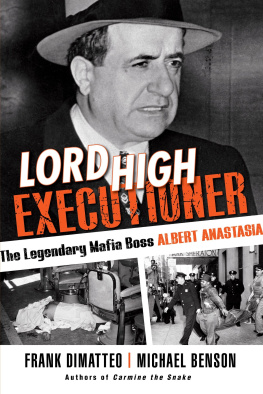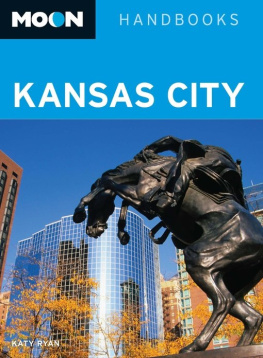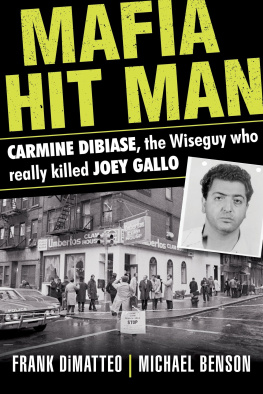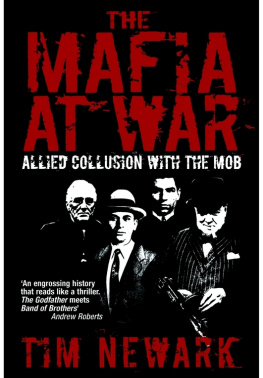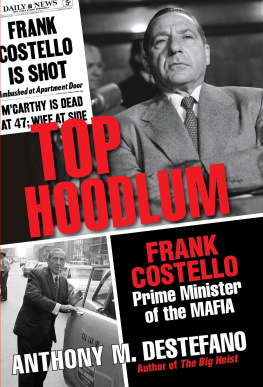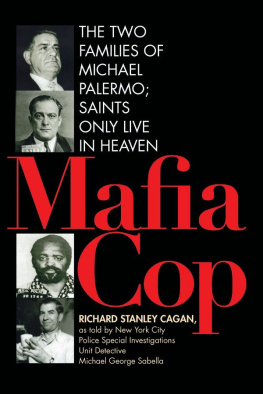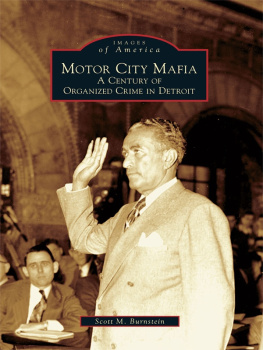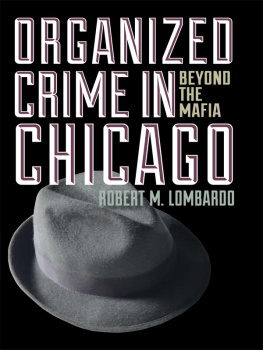ACKNOWLEDGMENTS
I WOULD FIRST like to acknowledge the institutions whose work uncovered the bulk of the information assembled in this book. They are the Kansas City Organized Crime Task Force, the Kansas City Crime Commission, and the Kansas City Star.
I am grateful to the Central Plains Branch of the National Archives and particularly Mr. Tim Reeves, who provided expert guidance through the case dockets of the U.S. District Court of Western Missouri, the records of which form a documentation base for this work.
Ms. Denise Morrison, a dedicated historian at the Kansas City Museum, Union Station Archives, provided much help, as did David Boutrous, the keeper of the Western Historical Manuscript Collection at the University of Missouri, Kansas City. The staff of the Missouri Valley Room at the downtown branch of the Kansas City Public Library provided me with a plethora of information in an inspiring setting.
As my search for information expanded beyond Kansas City, some very helpful professionals assisted me from afar. Liz Moore of the Nevada State Library and Archives graciously accommodated my requests. In St. Louis, Zelli Fischetti, Linda Belford, and especially Nancy McIlvany of the Western Historical Manuscript Collection at the University of Missouri, St. Louis, helped facilitate a historical treasure hunt that was as fun as it was fruitful. Deborah Cribbs, curator of special collections at the Universitys Mercantile Library was also extremely helpful.
A hearty thanks to Monica Schreiber, Brad Benz, Craig Smith, and Julie Glassman for their editorial efforts and encouragement. Thanks also to Star columnist Charles Gusewelle for his encouragement and efforts, and to Rick Porrello, Scott Dietche, Alan May, Carole Stuart, and Ivy McFadden of Barricade Books and AmericanMafia.com.
No one helped me with this book more than my father, backed by my mother. My deepest thanksa lifetimes worthgo to my parents.
T HE FOURTH AND final Spero hit suggested that the arms and legs of the KC Mob were still flapping around even if its head had been severed by Strawman. William Cammisano was released from his prison stint for extortion shortly after Nick Civella died. The so-called Rat had served an extra eighteen months for refusing to testify before the 1980 Senate subcommittee that featured Fred Bonadonna as the star witness. Cammisano was seventy-three years old when he hit the street, but authorities believed that he stepped right back into the action. Cammisano was thought to have taken over as boss when Anthony Tony Ripe Civella went away on bookmaking and racketeering charges in 1984.
Alfonso DArco, one-time boss of the Luchese family in New York, would later testify that Paul Vario, who was portrayed as Paul Cicero in Martin Scorceses film Goodfellas, introduced Anthony Civella to him as boss of the Kansas City family while the three men were housed in the federal prison in Springfield, Missouri. DArco also claimed that Civella asked him to mediate a dispute between KC and Pittsburgh over the proceeds of a rock concert, and that Tony Ripe introduced a visiting William Cammisano to him as a made man.
It is unknown whether DArco was referring to Cammisano Sr. or William Jr., who had been active in the familys lower and middle rungs for years, and stepped up toward the top in the early 80s. Shortly thereafter, he was investigated in connection with fraud at a construction company that contracted for Marriot Hotels. Willie Jr. never went to trial in the case, but he did go to prison in 1989 for obstruction of justice. By then Tony Ripe was back from prison and back in action as the boss of the family. Some sources suspected that there would be a power play between Civella and the elder Cammisano but that never happened. Anthony Cardarella and Felix Ferina, who had both been sentenced to ten years in the 1960 Omaha, Nebraska shooting of Kenneth Sheetz, were both eliminated shortly after Carl Spero was blown up at the used car lot, but the rest of the decade saw little in the way of gangland violence. An FBI affidavit from this period makes mention of new members being made into the family in 1987 but offers nothing in the way of names.
TONY CIVELLA WAS only on the street for four years before going to prison yet again in 1992 for a conspiracy to divert more than a million dollars worth of pharmaceuticals onto the gray market. One of the highlights of Tonys four years of freedom was a trip to Las Vegas for the twenty-fifth anniversary party of Oscar Goodmans law practice. Tony donned a tuxedo, cigar, and pinky ring at the future mayors party and hobnobbed with wiseguys, judges, and casino executives. Willie Cammisano Jr. came out of prison just as Tony Ripe was going back in. Following Civella to prison was Peter Simone, whom court documents from this time described as a high-ranking member of the Kansas City LCN [La Cosa Nostra ]. Peter Simone had pled guilty to laundering money from video poker machines.
Carl Cork Civella and William Cammisano Sr. died within three months of each other in late 1994 and early 19 95. Cammisano died from lung cancer at the age of eighty. Cork, who was still imprisoned, succumbed to complications from pneumonia at the age of eighty-four.
WILLIE CAMMISANO JR. was now the highest ranking man on the street, but only until Tony Ripe was released the following year. Willie and Tony soon found themselves under scrutiny from the Nevada Gaming Commission, which had had it in for Kansas City since the inception of the Black Book in 1960. Tony Ripe hired his old friend Oscar Goodman to represent him at his hearing before the commission, but Civella and Cammisano were both added to the List of Excluded Persons in the winter of 1997, one hundred years after the word Mafia first appeared in the Kansas City Star. Two years later, another KC man with alleged Mob ties named Peter Ribaste was added to the book.
Ribaste had served time in prison for submitting a fraudulent loan application to purchase a Chevrolet dealership and had drawn the attention of the Nevada Gaming Commission by hanging around Vegas and accepting a $100,000 loan from Ted Binion of Binions Horseshoe fame. With three people listed, Kansas City again had a disproportionate representation on the infamous list, a distinction earned at least in part to the authorities chagrin at Nick Civellas ability to wield such a strong influence in Las Vegas twenty years after they had first attempted to ban him. Las Vegas was so preoccupied with the Civellas that Tonys son Vincent, who wasnt even listed in the book and received no casino comps, created a buzz and made the Vegas papers when he visited the Strip in 1997.
In 1998 Carl DeLuna was paroled after twelve years in federal prison. The devoted family man was eager to spend time with his wife and children. He kept a low profile and stayed out of the news until 2005, when the Missouri Gaming Commission banned the seventy-seven year old man from Missouri riverboat casinos. The Missouri List of Excluded Persons was patterned after Nevadas Black Book. DeLuna joined seven others on the list, six of whom were from Kansas City. Listed along with Tuffy were his brother Frank DeLuna and brother in law Tony Civella, William Cammissano Jr., Peter Simone, and Dale Norris. The only non-Kansas Citian was Mathew Trupiano, a reputed St. Louis Mob figure. As of 2006, DeLuna is still not listed in Nevadas Black Book, though there have been grumblings in the Vegas press that he should be.
If Carl Speros death at the used car lot is not a sad enough ending to the story, then the death of Freddie Bonadonna certainly is. After his father was killed and his River Quay business destroyed, Bonadonna enrolled in the Witness Protection Program and moved his family to Naples, Florida, under the name Juliano. The family remained on edge for years, conducting drills and taking paranoid precautions as part of their daily routine. Freddie, like so many other members of the program, never adapted to a contrived lifestyle that required him to break away from his family and friends. He struggled with the bureaucracy of the program and was unable to make a living for many years because the program failed to provide him with documentation of his new identity. After years of looking over his shoulder, jumping through administrative hoops, and pining for his old entrepreneurial life, Freddie faced yet another crisis when his mother died and he entered into a bitter squabble with his relatives over her estate. The judge ruled against Fred and accused him of pretending to still be in the Witness Protection Program. Much of Freds life had ended in the River Quay back in the 1970s. What was left of it poor Freddie took with his own hand in the spring of 2002.



